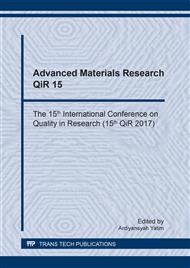p.116
p.121
p.128
p.136
p.142
p.150
p.158
p.171
p.177
Optimizing the Substrate Preheating Process of High Velocity Oxygen Fuel Cobalt-Based Alloy Coating on Alloyed and Carbon Steels Mechanical Properties
Abstract:
Tube boiler operating condition initiates common problems that can occur as a problem in the wear resistance material. It leads to a decreased function of the material so that it is necessary to repair or replacement. High Velocity Oxygen Fuel (HVOF) is regarded as one of the effective methods to increase the wear resistance of the material. In this study, the materials were ASTM SA213-T91 as a material commonly used for boiler tube and JIS G 3132 SPHT-2 as an alternative material. In the early stages, both of specimens were given initial surface heating with temperature variations 0, 50, 100 and 150oC. The materials were then coated with Stellite-1 using HVOF method. The material were then characterized for the microstructure, porosity, hardness distribution, and wear resistant. The results showed that the coating Stellite-1 as a top coat with HVOF method can improve the performance of the material. Microhardness increases from 220 HV to 770 HV on ASTM SA213-T91, while on the substrate JIS G 3132 SPHT-2 the microhardness increased from 120 HV to 750 HV. Better wear resistance was achieved with increasing preheating [1]. Wear resistance of the materials increased from the range 3.69x10-7 at 0°C preheating up to 0.89x10-7 on a specimen with initial surface heating 150oC. Porosity also decreases with the increasing preheating temperature.
Info:
Periodical:
Pages:
142-149
Citation:
Online since:
August 2018
Keywords:
Price:
Сopyright:
© 2018 Trans Tech Publications Ltd. All Rights Reserved
Share:
Citation:


